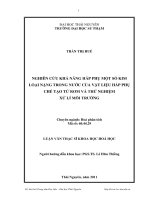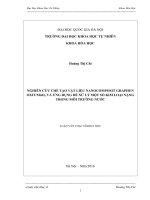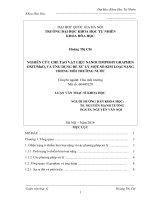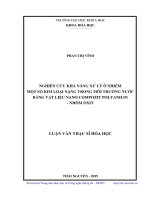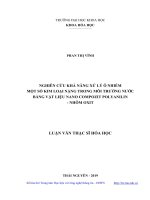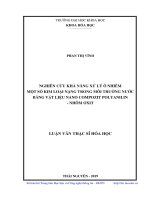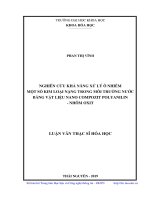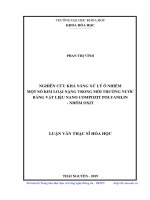Thực trạng ô nhiễm một số kim loại nặng trong môi trường nước, thực phẩm, sức khoẻ dân cư ở một khu vực ven biển huyện thuỷ nguyên hải phòng và thử nghiệm giải pháp can thiệp tt tiếng anh
Bạn đang xem bản rút gọn của tài liệu. Xem và tải ngay bản đầy đủ của tài liệu tại đây (975.96 KB, 27 trang )
MINISTRY OF EDUCATION
AND TRAINING
MINISTRY
OF HEALTH
HAIPHONG UNIVERSITY OF MEDICINE AND PHARMACY
NGUYEN THI MINH NGOC
STATE OF HEAVY METAL CONTAMINATION IN WATER,
FOOD; COMMUNITY PEOPLE’S HEALTH IN THE COASTAL
AREA OF THUYNGUYEN DISTRICT, HAIPHONG
AND RESULTS OF AN EXPERIMENTAL INTERVENTION
Major: Public Health
Code: 62 72 03 01
SUMMARY OF DOCTORAL THESIS
HAIPHONG - 2020
THE DISSERTATION WAS COMPLETED AT
HAIPHONG UNIVESITY OF MEDICINE AND PHARMACY
Academic superviors:
1. Assoc. Prof. Ho Anh Son
2. Assoc. Prof. Pham Van Han
Reviewer 1:
Reviewer 2:
The dissertation will be defended at Council University of Dissertation
Assessment at Haiphong University of Medicine and Pharmacy.
Time: …… date ……… month ………. year 2020
The dissertation can be found at:
1. The National Library
2. The library of Haiphong University of Medicine and
Pharmacy
1
AC
ADD/ADI
ALA
BW
CR
CSF
ED
EF
ML
HI
HQ
HM
Min
Max
RfD
USEPA
WHO
LIST OF ABREVIATIONS
Activated carbon
Average daily dose/ Acceptable Daily Intake
Delta-aminolevulinic dehydratase
Body weight
Cancer risk
Cancer slope factor
Exposure dose
Exposed frequency
Maximum level
Hazard index
Hazard quotient
Heavy metal
Minimum
Maximum
Reference dose
United State Environmental Protection Agency
World Health Organization
INTRODUCTION
According to the World Health Organization (WHO), globally,
there were 12.6 million deaths (23%) caused by environmental
pollution in 2012.[1]. One of the major threats to ecological and human
health is environmental contamination and pollution by heavy metals.
Among the environmental pollutants, there is an increasing need for
research on heavy metals because they are toxic, easily bioaccumulate,
difficult to decompose and therefore persistent, and can pose risks to
ecological and human health.[2,3] The Minamata disaster caused by
organic mercury pollution in Chisso Bay, Japan is the classic evidence
of coastal water pollution with serious consequences on the ecosystem
and community health.[4]. The results of some studies showed that
heavy metal contamination in water, vegetables and seafood was
detected in some areas of Vietnam. Cd and Pb were detected as the
main pollutants in surface sediments, Red River basin by Nguyen Thi
Thu Hien (2016), Testuro Agusa (2014) [5,6] while As, Cr and Hg were
higher than the permissible limit in the Mekong Delta [7]. High
concentrations of heavy metals (As, Cd, Cr, Pb) in oyster tissue and
green mussels were seen in coastal Can Gio và Do Son-Dinh Vu [8, 9].
2
With a 3200 km long coastline and 28 coastal provinces, the
marine environment plays an important role for the socio-economic
development of Vietnam [10]. Thuy Nguyen, Hai Phong is a coastal
district that has been interested in exploiting geographical advantages in
socio-economic development with the construction and expansion of
factories and production enterprises. Currently, only limited data on the
levels of heavy metal contamination in food, especially heavy metal
contamination in vegetables and seafood in Thuy Nguyen, Vietnam, are
available.
Based on the evidence described above, the study State of heavy
metal contamination in water, food; community people’s health in the
coastal area of Thuynguyen District, Haiphong and results of an
experimental intervention was caried out with following objectives:
1. To identify the state of heavy metal pollution in water and food in
two coastal communes of Thuy nguyen District, Haiphong city in 20172018.
2. To describe the pattern of disease and the risk due to exposure to
heavy metal contamination among community residents in the study
area.
3. To evaluate the effectivenss of removing heavy metals from water
with castor activated carbon in 2018-2019.
THE NEW CONTRIBUTION OF THE THESIS
This is one of the first studies in Vietnam which describes
heavy metal contamination in water and food, and calculates the
estimation of human health risk from heavy metal exposure in a
particular coastal area in Vietnam.
A slow filtration tank was developed and used to remove heavy
metals from water with castor activated carbon. The results showed that
castor activated carbon was highly effective in the laboratory and in the
field.
THESIS STRUCTURE
There are 120 pages in the main part of the thesis, which consists
of the following sections: Introduction: 2 pages, Chapter 1 - Literature
review: 34 pages, Chapter 2 - Materials and Methods: 26 pages, Chapter
3 - Results: 28 pages, Chapter 4 - Discussion: 27 pages, Conclusions
and recommendations: 3 pages. There are 40 tables, 12 figures, and a
total 7 related Appendices of 19 pages in the thesis. 149 references in
which 29 Vietnamese and 120 English, were cited.
3
Chapter 1 : LITERATURE REVIEW
1.1. Heavy metal pollution in water and food in coastal areas
1.1.1 The source, metabolism in nature and effect of heavy metals
Heavy metals (HMs) are metals that have a density greater than
5g/cm3 in comparison to water. HMs can be released from both natural and
artificial activities. Based on the level of immediate threat to human health
and the environment, As, Pb, Cd, Cr and Hg are the HMs that most concern
the community and WHO.[13]
Figure 1.1. Source of heavy metals and their cycle in the environment [26]
Figure 1.2. Impact of heavy metals on the environment [26]
1.1.2. Current state of heavy metal contamination in water and food
in Vietnam and globally
1.1.2.1 Global
The concentration of HMs in seafood, especially in in the muscle
and liver of the organisms, has been studied by many Asian authors.
4
Some studies have found that the concentration of HMs in fish and
shrimp commonly consumed in the Arabian Gulf and Malaysia met the
national permitted limits [28, 29]. However, one study in Jizan, Saudi
Arabia, Red Sea, 2013, found that the average concentration of HMs in
the country exceeded the recommended value of WHO/USEPA and
decreased gradually in the order of Cr> Pb> As > Cd [30]. Oteef et al.
(2015) detected Pb and Cd in leafy vegetables, (arugula and spinach) in
Saudi Arabia, [38]; Husain, 2020 had identified relatively high
concentrations of Cr in spinach, lettuce and carrots in the United Arab
Emirates [39].
1.1.2.2. In Vietnam
Pham Long Hai et al. (2016) found that the As concentration in
83% of groundwater samples in Hanam exceeded WHO’s recommended
drinking water limits (10 µg/L) [43]. As, Pb and Cd in vegetables,
especially in water spinach and lettuce, in Hanoi, Thai Nguyen, Bac Kan
provinces were detected at higher levels in comparision to permissible
standards [51, 52].
1.2. Disease pattern and human health risk of heavy metal exposure in
coastal areas
1.2.1. Risk Assessment
1.2.2. Disease pattern in coastal areas in Vietnam and in the world
According the Institute of International Health Assessment and
WHO, the leading causes of death globally shows an increasing trend of
morbidity and mortality from non-communicable diseases (NCDs) while
infectious diseases have been decreasing. In particularly, NCDs remain the
biggest burden globally, especially in low and middle-income countries,
including Vietnam. [58, 59].
In Vietnam, causes of morbidity are classified into three main
groups: infectious diseases, non-communicable diseases and accidental
poisoning. According to statistics from the Ministry of Health in 2016, the
group of non-communicable diseases accounted for the highest proportion
with 69.1%, an increase of 65.6% compared to 2015. In the past 5 years,
the disease pattern has evolved with the trend that the non-communicable
disease accounts for 2/3 of the total disease causes while contagious
diseases account for about a quarter of the remaining diseases; the
remainder result from accidents, poisoning, injury.[58, 60]
1.2.3. Human health risk due to exposure to drinking water,
vegetable and seafood contaminated with heavy metals
5
- Risk assessment method
Hazard = Risk factor + exposure.[62]
- Human health risk from exposure water, vegetable and seafood
contaminated with heavy metals
In Vietnam, the data for estimating the human health risk from
exposure of HMs from consuming vegetables and seafood is limited. The
cancer risk of As contaminated groundwater ranged from 5 x 10-4 in Ha
Nam to 8.26 × 10-2 in An Giang [73], [77]. The human health risk of As
contaminated vegetable was investigated in Vinh Quynh, Hanoi (2015)
[74].
- Current state of heavy metal exposure measured in biological samples
16% of urine samples were found to have higher concentrations of
HMs than the normal limit in some studies done in HaNam province [79],
[80].
1.3. Strategies to remove heavy metals from water
Worldwide, the removal of heavy metals is an important step to
ensure safe drinking water. Some of the common methods used to remove
heavy metals include chemical precipitation, flocculation-forming,
membrane filtration, ion exchange, electrochemical and adsorption.[85]. In
Vietnam, some authors have researched solutions for removing heavy
metals in water, however, mainly focusing on arsenic removal in
groundwater because it is a common water pollutant in rural areas.
Adsorption with a variety of materials (mineral coal, fiber/coconut shell) in
conjunction with filtration is used to remove arsenic from the water.
Chapter 2. MATERIALS AND METHODS
2.1. Study subjects, study area and study time
*Study subjects: (1) Water samples: 54 surface water samples and 222
drinking (well) water samples; (2) Food samples: 40 seafood samples (10 for
each seafood [tiger shrimp, stuffed snails, snake-head fish, and catfish]) were
collected at the 2 biggest open markets and the residents’ fish ponds in the
study area; The most commonly grown and consumed vegetables including 12
leafy vegetables, 4 pea plants, 4 tuber vegetables, and 7 herbs were collected;
(3) Study population: Residents who were at least ≥18 years old and had been
living ≥3 yrs in the study area, which is 1500 m distance from the industry
plants.
6
*Study location and time: Study was conducted in Tam Hung and Minh Duc
communes, Thuynguyen district, Haiphong city, from December 2016 to May
2019.
2.2. Research methods
2.2.1. Study design: 2 periods
- 1st stage: From December 2016 to May, 2017: Cross-sectional
descriptive study
- 2nd stage: From May 2017 to May 2019 conducting experimental
intervention study comparing the results of removing heavy metals by
using a slow filtration tank with castro tree activated carbon in the
laboratory (6 months) and in field (Tam Hung commune in 18
months).
2.2.2. Sample size and sampling methods
* Sample size and sampling for the 1st objective: Applying the formula of one
proportion and mean value estimation to calculate the sample sizes we need
for analysis, a total of 54 surface water samples, 222 drinking water (well)
samples) and 135 vegetable samples and 40 seafood samples, which were
larger than theorical sample sizes were selecleted. All samples were selected
by the poroportion sampling methods in the study areas.
*Sample size and sampling for the 2nd objective: Applying the formula to
estimate one proportion to determine the sample sizes needed for interviews
and biological samples, the quantities of selected samples of community
residents (1010 people and 450 urine, 450 blood samples) were larger than
the calculated sizes.
For sampling to investigate the disease pattern, 1010 community residents
(522 persons from TamHung and 490 persons from Minh Duc) were randomly
selected from the list of residents who meet the inclusion criteria community
people.
For urine and blood sampling: 450 people who have symptoms and signs
of heavy metal exposure were selected from 1010 local people during medical
examinations and interviews.
2.2.3. Study contents, Study variables and indicators
- 1st objective:
+ The heavy metal concentration in surface water, well water (mg/l),
vegetable and seafood samples (mg/kg)
- 2nd objective:
+ Blood heavy metals (μg/dl), and Urine heavy metals (μg/l)
7
+ The rate of commmunity residents who suffer from the disease by ICD
10 classification
+ Distribution of heavy metal exposure by gender
+ Distribution of common disease proportion by heavy metal exposure
+ The proportion of people having with poisoning symptoms by heavy
metal exposure
+ The risk quotient due to HMs contaminated vegetables and seafood
consumption
+ Hazard index (HI) for each type of vegetables and seafood
+ Estimated human risk of HMs contaminated water
+ Estimated human health risk from HMs contaminated vegetable and
seafood
- 3rd objective:
+ Intervention effectiveness: Heavy metal removing indicator before and
after using castro activated carbon filtration in laboratory and in the field
+ Efficiency indicator
2.4. Data collection techniques and tools
*Techniques of collecting information on environmental samples
(agricultural land, surface water and well water) and blood and urine
samples: complied with the Technical Regulation on Environmental and
Occupational Health, Institute of Occupational and Environmental
Health)[99]. Environmental samples, blood and urine samples, after being
collected, will be analyzed and assessed for concentrations of As, Pb, Cd,
Cr and Hg at the Military Medicine Research Center, the Military
Medical Academy according to the corresponding technique as follows:
*Samples of surface water, well water, vegetables, seafood: the HM
concentration were determined with atomic absorption spectroscopy.
Evaluate the results of As, Pb, Cd, Cr and Hg contents in surface
water and well water respectively according to QCVN 08 MT:
2015/BTNMT and QCVN 01: 2009/BYT [101,102].
Evaluate results of As, Pb, Cd and Cr, Hg content in vegetables
according to Decision No. 99/2008/ QD-BNN & PTNT [103]
Evaluate results of As, Pb, Cd, Cr and Hg content in seafood
according to National Standards on food according to QCVN 8-2: 2012
/BYT [104]
* Blood Pb and Cd were examined with atomic absorption
spectroscopy
8
*24 hour urinary As, ALA, Cr and Hg concentations were determined
with atomic absorption spectroscopy and plasma mass spectrometry.
*Data collection techniques and tools for health status, risks and
signs of heavy metal poisoning (As and Pb contamination),
frequency of vegetables and seafood consumption
Study subjects were examined and interviewed using the health
examination form of the Ministry of Health and previous studies on
signs and symptoms of HM poisoning. (Appendix 1)
Questionnaire of daily consumption frequency and human health
risk of chemical exposure from food (vegetables, seafood) during the
last 7 days (Appendix 2)
* The evaluation methods for the human health risk of consuming HM
contaminated wellwater, seafood (fish, shrimp, snail) and vegetables:
applying US.EPA and WHO guidelines to calculate the hazard
quotient (HQ), hazard index (HI), cancer risk [105, 106].
HQ = [(C x FIR x ED x EFr)/ (BW x AT x RfD)] x 10-3
HI = ∑HQi = HQKLN1 + HQKLN2 + HQKLN3 + … + HQn
CR = [(EF x ED x FIR x C x CSF0)/(BW x AT)] x 10-3
In which:
C: HM concentrations in vegetables, fish tested (mg/kg). According to
the survey, the average fish consumption for male and female is 0.02
kg/day and 0.0165 kg/day, respectively; The amount of vegetables
consumed was 0.065 g/person/day in both genders.
RfD is referance dose (As = 0,0003, Cd = 0,001, Pb = 0,0035, Cr = 1,5
(mg/kg/day)).
BW is the body weight (kg). Our survey results showed the average
weight of study subjects is 55.86 kg for men and 44.26 kg for women.
i is the different heavy metals
CSF0: Potential oral carcinogenicity coefficient (mg/kg bw/day)
Results evaluation: HQ > 1: potential risk to human health
HI > 1: high risk to consumers’ health
CR = 10-6 - 10-4: acceptable cancer risk level
*Data collection for experiment intervention period
Testing of heavy metal removal by the slow filter tank model in the
laboratory with 2 types of filtation materials: (1) with coconut shell/skull
activated carbon with As, Pb, Cd and Cr contaminated hypothetical
samples at 9 volumes (from 1-48 liters); (2) with castor plant activated
carbon at 10 volumes of water (from 20 - 2600 liters).
9
Tested removal of heavy metal with a slow filter tank model with
castor activated carbon filter material) at 4 wells in the field for 18
months. Water samples were collected at the test tank daily for the first
month and every Sunday in plastic bottles and stored at 40C, and
transported weekly to the laboratory at the Military Institute of Medicine
and Pharmacy, Military Medical University to determine the
concentration of HMs
o Intervention supervision:
The content and procedure of the experiment intervention in the
laboratory (6 months) and in the field (18 months) were supervised by
principal researchers and researchers of the Military Medical Research
Institute, Military Medical Academy.
Tool for assessing the concentration of HMs in the water: testing
the concentration of HMs in the water according to the technique used
in the pre-intervention stage
Evaluation of filtration results and efficiency index
Comparison of HMs content in water samples tested in the
laboratory and in the field (after 18 months) with QCVN 01: 2009/BYT
Calculate the efficiency indicator after filltration intervention
2.5. Data analysis
The collected data were entered in Excel and analysed by SPSS 22.0.
2.6. Ethical approval
The study followed and complied with the study protocol
approved by the Approval Council of Hai Phong University of
Medicine and Pharmacy. The consent form was collected from all study
subjects, Thuy Nguyen District Medical Center, the People's Committee
and people of Minh Duc, Tam Hung, Thuy Nguyen district, Hai Phong.
The purpose, content and meaning of the study were clearly explained
to community people who signed voluntary consent to participate in
research. All personal information is kept confidential and used only for
research purposes. The research results are aimed to improve the
drinking water quality and the communities health in Tam Hung and
Minh Duc communes, Thuy Nguyen district, Hai Phong city.
Chapter 3. RESEARCH RESULTS
3.1. Current state of heavy metal contamination in water and food in the
coastal area of Thuy Nguyen district, Hai Phong in 2017-2018
10
Table 3.1. The concentration of heavy metals in surface water (n=54)
Concentration
No sample
MLs
(mg/L) Min
Max Mean over MLs
QCVN 08:2015
(n, %)
HMs
As
0.02
0.42
0.19
54 (100)
≤ 0.01
Pb
0.03
0.39
0.17
54 (100)
≤ 0.02
Cd
0.00
0.03
0.02
53 (98.15)
≤ 0.005
Cr
0.32
4.32
2.56
53 (98.15)
≤ 0.050
Hg
KPH
0 (0.00)
≤ 0.001
Table 3.2. The concentration of HMs in well water (n=222)
Concentration
No sample
ML
(mg/L) Min
Max Mean over MLs National Standards
(n, %)
01:2009/MOH
HMs
As
0.01
0.48
0.06 185 (83.33)
≤ 0.01
Pb
0.01
0.42
0.12 210 (94.59)
≤ 0.01
Cd
0.00
0.15
0.03 188 (84.68)
≤ 0.003
Cr
0.02
0.82
0.25 166 (74.77)
≤ 0.05
Hg
KPH
0 (0.00)
≤ 0.001
The percentage of well water samples which did not meet the national
standard in HMs were highest with Pb (94.59%), then followed by As, Cd,
and Cr.
Table 3.3. The concentration of HMs in vegetable samples (n=135)
No sample
Decision
over MLs
99/2008/MARD
(n, %)
As
0.17 1.69
0.87
52 (38.52)
≤ 1.0
Pb
0.11 1.96
0.80
123 (91.11)
≤ 0.3
Cd
0.00 3.27
0.82
95 (70.37)
≤ 0.1
Cr
0.02 1.57
0.51
107 (79.26)
≤ 0.1
Hg
0.00 0.04
0.01
0
≤ 0.05
The percentage of vegetable samples with concentrations of HMs higher
than the permitted standard for Pb (91.11%), followed by Cr (79.26%) and Cd
(70.37%) and lowest in As (38.52%).
Concentration
HMs
Min
Max
Mean
Table 3.4. The concentration of heavy metals in seafood samples (mg/kg)
11
Seafood Snake-head fish
HMs
Catfish
Mean
N*
Mean
(Min, Max) (n, %) (Min, Max)
Stuffed Snail
N*
Mean
(n, %) (Min, Max)
Tiger Shrimp
N*
(n, %)
Mean
(Min, Max)
N*
(n, %)
-
0.80
(0.77-0.81)
-
As
1.18
(1.18-1.19)
-
1.66
(1.56-1.80)
-
0.80
(0.77-0.81)
Pb
0.08
(0.07-0.09)
0
0.10
(0.08-0.12)
0
1.24
10
1.24
10
(0.72-1.76) (100) (0.72-1.76) (100)
Cd
2.30
10
1.06
(1.91-2.74) (100) (0.94-1.18)
Cr
2.12
(1.96-2.31)
-
2.25
(2.04-2.47)
Hg
ND
0
ND
10
1.62
10
1.62
10
(100) (1.35-1.97) (100) (1.35-1.97) (100)
1.46
(1.03-1.87)
-
1.46
(1.03-1.87)
-
ND
0
ND
0
0
N*: No sample over MLs; ND: not detected
3.2. State of disease structure and the human health risk due to heavy
metal contamination and exposure in the study area
Table 3.5. The distribution of common diseases by gender
Disease group
Circulatory system
Respiratory system
Digestive system
Urinary system
Motor System
Endocrine systemmetabolism disease
Ear - Nose - Throat
Tooth - Jaw - Face
Eye disease
Skin disease
Nervous system
Infectious disease
Male (n =447)
Female (n= 563)
Total
(n=1010)
p
n
179
136
223
35
196
%
40.04
30.43
49.89
7.83
43.85
n
240
166
264
37
236
%
42.63
29.48
46.89
6.57
41.92
N
419
302
487
72
432
%
41.49
29.90
48.22
7.13
42.77
0.41
0.75
0.34
0.44
0.54
82
18.34
98
17.41
180 17.82
0.69
155
373
107
152
215
273
34.68
83.45
23.94
34.00
48.10
61.07
143
477
141
244
280
330
25.40
84.72
25.04
43.34
49.73
58.61
298
850
248
396
495
603
<0.01
0.58
0.68
<0.01
0.61
0.43
29.50
84.16
24.55
39.21
49.01
59.70
12
The rate of common diseases in adults is quite high, with the highest
rates of diseases of the teeth - jaw - face, infectious, digestive diseases,
circulatory diseases and skin diseases.
3.2.2. HM concentrations in blood and urine samples of study subjects
Table 3.6. HM concentrations in blood and urine samples (n=450)
Concentration
HMs
Blood_Pb (g/dL)
Blood_Cd (g/l)
Urine_As (g/l)
TB SD
Min – Max
N*
(n, %)
9.06 ± 0.99
6.23-11.35
96 (21.33)
< 10
(0.0)
-
174 (38.67)
< 60
96 (21.33)
<5
-
-
(0.0)
-
KPH
69.96 ± 23.38 44.65- 43.32
U_ALA (mg/l)
4.50 ± 1.59
2.16 - 11.24
U_ Cr (g/l)
40.04 ± 6.97 21.38 - 86.56
U_Hg (g/l)
1.32 ± 0.51
0.37 -3.50
Normal
value
*
N : Samples exceeded normal level
21.33% of samples had blood Pb, urinary ALA and 38.67% had
urinary As higher than the normal threshold.
Table 3.7. Distribution of HM exposure by gender (n=450)
Female
Total (n=450)
Gender Male (n=225) (n=225)
p
HMs exposure
No
%
No
%
No
%
86 38.20 99
44.00
185 41.10
Yes*
0.213
No
139 61.80 126 56.00
265
58.90
*: B_Pb ≥ 10 g/dL or U_As > 60 or U_ALA ≥ 5 mg/L
41.10% of local people had HM exposure, however there was
no difference in HM exposure rate by gender (p>0.05).
13
3.2.3. The assocation between HM exposure and health indicators
among study subjects
Table 3.8. The assocation between poisonous symptoms and HM exposure
among study subjects
HMs exposure Yes (n= 185)
No (n =265)
OR
p
(95%CI)
n
%
n
%
Symptoms
5.14
Asthenia
133
71.89
88
33.21
< 0.01
(3.41 - 7.75)
3.15
Neurasthenia
126
68.11
107
40.38
< 0.01
(2.13 - 4.68)
5.22
Hair loss
74
40.00
30
11.32
< 0.01
(3.23 - 8.44)
4.41
Sensory disorder
65
35.14
29
10.94
< 0.01
(2.70 - 7.19)
Vasomotor
4.91
118
63.78
70
26.42
< 0.01
disorder
(3.27 - 7.36)
16.69
Thick horn/nails
11
5.95
1
0.38
< 0.01
(2.14-130.43)
Skin pigmentation
7.03
18
9.73
4
1.51
< 0.01
disorders
(2.34 - 21.14)
Tumor
16
8.65
0
0.00
< 0.01
8.24
Pregnancy disease
5/22 22.73 1/29
3.45
0.03
(0.89 - 76.59)
The morbidity rate of some poisonous symptoms/diseases in the
exposed group were significantly higher than the non-exposed (p<0.05).
Specifically, the highest prevalence of diseases/symptoms was keratosis, skin
pigmentation disorder.
* Human health risk related to HM contaminated drinking water
Table 3.9. Estimated HM doses taken into the human body through digestive route
Dose/day
D
TDI
No sample over TDI
HMs
(mg/kg/day)
(mg/kg/day)
n (%)
Arsenic
0.0031 ± 0.0006
0.002
114 (51.35)
Lead
0.0030 ± 0.0041
0.003
144 (64.86)
Cadimium
0.0012 ± 0.0004
0.060
0 (0)
Chromium
0.0066 ± 0.0078
0.300
0 (0)
14
51.53% and 64.86% of households using well water which
contaminated with As and Pb for drinking with D > TDI, respectively.
*Cancer risk estimation related to HM contaminated well water
Table 3.10 Cancer risk estimation related to As contaminated well water
Variable
Acceptable
cancer risk
Min
Max
SD
R1
3.2 x 10-3 5.8 x 10-3 4.6 x 10-3 0.9 x 10-3
R2
3.8 x 10-3 6.9 x 10-3 5.5 x 10-3
1.1 x 10-3
10-6 - 10-4
-3
-3
-3
R3
4.8 x 10
8.7 x 10
6.9 x 10
1.4 x 10-3
R4
27.7 x 10-3 50.1 x 10-3 40.1 x 10-3 8.2 x 10-3
Note: R1 : cancer risk at present with current exposure among local adults;
R2 : cancer risk at 5 years later with current exposure among local adults
R3 is cancer risk at 10 years later with current exposure among local adults
R4 is cancer risk at the whole life year with current exposure among local
adults
All the risk estimations were higher than the acceptable level.
Table 3.11. Cancer risk estimation related to Pb contaminated well water
Variable
Acceptable
risk level
Min
Max
SD
R1
3,12 x 10-6 8,73 x 10-5 2,56 x 10-5 3,50 x 10-5
R2
3,74 x 10-6 10 x 10-5 3,07 x 10-5 4,20 x 10-5
10-6 - 10-4
R3
4,68 x 10-6 10 x 10-5 3,83 x 10-5 5,25 x 10-5
R4
2,71 x 10-5 80 x 10-5 20 x 10-5 30 x 10-5
The estimated average cancer risks related to Pb contaminated
water at any time points were under and below accetaple risk level.
Table 3.12. Cancer risk estimation related to Cd contaminated well water
Variable
Acceptable
risk level
Min
Max
SD
3 x 10-4
6 x 10-4
5 x 10-4
1 x 10-4
-4
-4
-4
3 x 10
8 x 10
6 x 10
2 x 10-4
10-6 - 10-4
-4
-4
-4
4 x 10
10 x 10
7 x 10
2 x 10-4
24 x 10- 56 x 10-4
40 x 10-4
12 x 10-4
The current estimated cancer risk among adults in Tam Hung and
Minh Duc communes from using Cd contaminated well water for
drinking at any time points were higher than the acceptable level.
R1
R2
R3
R4
Table 3.13. Estimated cancer risk related to Cr contaminated well water
15
Variable
Acceptable
risk level
Min
Max
SD
R1
5 x 10-4
9.4 x 10-3 3.3 x 10-3 3.9 x 10-3
-4
R2
6 x 10
11.2 x 10-3 4.0 x 10-3 4.7 x 10-3
10-6 - 10-4
R3
7 x 10-4
14.0 x 10-3 5.0 x 10-3 5.8 x 10-3
-4
R4
41 x 10
81.2 x 10-3 28.7 x 10-3 33.8 x 10-3
The current estimated cancer risk among adults from using Cr
contaminated well water for drinking at any time points were higher than
the acceptable level.
*Cancer risk related to HM contaminated food consumption
Table 3.14. Estimated cancer risk related to HM contaminated
vegetable consumption by gender
Cancer risk
Min
Max
SD
HMs
Male
2,97 x 10-7
2,96 x 10-6
1,51 x 10-6
6,03 x 10-7
As
-7
-6
-6
Female 3,74 x 10
3,74 x 10
1,90 x 10
7,61 x 10-7
-9
-8
-9
Male
1,09 x 10
1,94 x 10
7,91 x 10
3,30 x 10-9
Pb
Female 1,37 x 10-9
2,45 x 10-8
9,99 x 10-9
4,16 x 10-9
-9
-9
Male
0,00
6,85 x 10
1,72 x 10
1,37 x 10-9
Cd
-9
-9
Female
0,00
8,64 x 10
2,17 x 10
1,72 x 10-9
Male
9,89 x 10-9
9,13 x 10-7
2,97 x 10-7
1,92 x 10-7
Cr
-8
-6
-7
Female 1,25 x 10
1,15 x 10
3,74 x 10
2,42 x 10-7
The estimated risk of cancer due to HM contaminated vegetables
consumption in both gender were highest from As. and lowest with Cd.
Table 3.15. Estimated cancer risk related to HM contaminated
seafood consumption by gender
Cancer risk
Min
Max
SD
HMs
Male
4.37 x 10-7
1.02 x 10-6 6.82 x 10-7
1.77 x 10-7
As
-7
-6
-7
Female
4.37 x 10
1.01 x 10
6.76 x 10
1.76 x 10-7
-10
-9
-9
Male
2.20 x 10
8.63 x 10
2.83 x 10
2.91 x 10-9
Pb
-10
-9
-9
Female 2.19 x 10
8.56 x 10
2.80 x 10
2.88 x 10-9
Male
6.36 x 10-10
2.48 x 10-9 1.39 x 10-9
5.81 x 10-10
Cd
-10
-9
-9
Female 6.31 x 10
2.46 x 10
1.38 x 10
5.76 x 10-10
-7
-7
-7
Male
1.94 x 10
4.64 x 10
3.54 x 10
7.70 x 10-8
Cr
Female
1.92 x 10-7
4.60 x 10-7 3.51 x 10-7
7.64 x 10-8
16
The estimated risk of cancer due to HM contaminted seafood
consumption in both genders was highest with As > Cr > Pb > Cd, but
are lower or within the acceptable level.
3.3. Experimental results of removing heavy metals in water with
activated carbon
3.3.1. Experimental results from laboratory tests
Table 3.16. Results in removing As with coconut shell &castro active
carbon
Tested
Coconut shell AC
Castro AC
Tested
V (L) Input
V(L)
0.1
1.0
Input
0.1
1.0
1
0.059 0.920
< 0.005 < 0.005
20
2
0.068 0.946
< 0.005 < 0.005
300
3
0.085 0.975
< 0.005 < 0.005
600
4
0.088 0.983
< 0.005 < 0.005
900
Output
Output
6
0.092 0.987
< 0.005 < 0.005
1200
8
0.094 0.988
< 0.005 < 0.005
1500
12
0.093 0.990
< 0.005
0.015
1800
24
0.096
< 0.005
0.028
2100
< 0.005
0.048
2400
48
0.097
< 0.005
0.062
2600
Note: National permissible standard: As < 0.01 ppm
No output As concentrations met the permissible standard was seen with
coconut shell material. However, with castor AC filtration, the output of As
met the permissible standard in 2600 liters and 1500 litres.
Table 3.17. Results in removing Pb with coconut shell and castro active carbon
Tested
V (L)
1
2
3
4
6
8
12
24
48
Coconut shell AC
Castro AC
Tested V
Input
(L)
0.1
1.0
Input
0.1
0.061 0.922
20
< 0.01
0.070 0.948
300
< 0.01
0.087 0.977
600
< 0.01
0.090 0.985
900
< 0.01
1200 Output < 0.01
Output 0.094 0.989
0.096
0.99
1500
< 0.01
0.095 0.992
1800
< 0.01
0.098
2100
< 0.01
2400
< 0.01
0.099
2600
< 0.01
1.0
< 0.01
< 0.01
< 0.01
< 0.01
< 0.01
< 0.01
0.016
0.029
0.050
0.058
17
Note: National permissible standard: Pb < 0.010 ppm
Similar results were seen in removing Pb from water with coconut shell
and castro activated carbon.
Table 3.18. Results in removing Cd with coconut shell and castro AC
Tested
V (L)
1
2
3
4
6
8
12
24
Coconut shell AC
Castro AC
Tested V
Input
(L)
0.03
0.3
Input
0.03
0.3
0.018 0.276
20
< 0.003 < 0.003
0.021 0.284
300
< 0.003 < 0.003
0.026 0.293
600
< 0.003 < 0.003
0.027 0.295
900
< 0.003 < 0.003
0.028 0.296 1200
< 0.003 < 0.003
Output
Output
0.029 0.297 1500
< 0.003 < 0.003
0.028 0.992 1800
< 0.003
0.008
0.029
2100
< 0.003
0.016
2400
< 0.003
0.025
48
0.018
2600
< 0.003
0.046
Note: National permissible standard: Cd < 0.003 ppm
Similar results were seen in removing Cd from water with coconut shell
and castro activated carbon.
Table 3.19. Results in removing Cr with coconut shell and castro activated carbon
Castro AC
Tested
V (L) Input
0.5
5.0
20
< 0.05 < 0.05
300
< 0.05 < 0.05
600
< 0.05 < 0.05
900
< 0.05 < 0.05
1200 Output < 0.05 < 0.05
1500
< 0.05 < 0.05
1800
< 0.05
0.059
2100
< 0.05
0.062
2400
< 0.05
0.089
48
0.500
2600
< 0.05
0.091
Note: National permissible standard: Cr < 0.05 ppm
Similar results were seen in removing Cr from water with
coconut shell and castro activated carbon.
Tested
V (L)
1
2
3
4
6
8
12
24
Coconut shell AC
Input
0.5
5.0
0.310
4.615
0.355
4.745
0.440
4.890
0.455
4.930
4.950
Output 0.475
0.485
4.955
0.480
4.965
0.495
3.3.2. Experiment results of removing heavy metals in the field
18
Table 3.20. Experiment results of removing heavy metals in the field
Pb
Cd
Cr
HMs As
Wellwater
(1)
(1)
(1)
(1)
(2)
(2)
(2)
(2)
st
1 well
0.40 <0.01 0.03 <0.01 0.12 <0.003 0.25 <0.003
2nd well
0.11 <0.01
0.42
<0.01
0.15
<0.003
0.82
<0.003
3rd well
0.45 <0.01
0.32
<0.01
0.12
<0.003
0.85
<0.003
th
4 well
0.13 <0.01 0.18 <0.01 0.10 <0.003 0.62 <0.003
QCVN
≤ 0,01
≤ 0,01
≤ 0,003
≤ 0,05
01:2009/BYT
Effective
96,33
95,79
97,55
99,53
Index
(1): Before filtration; (2): After filtration
The concentration of HMs in all four experimented wells met the National
permissible standard QCVN 01: 2009/MOH, the filtration efficiency ranged
from 95-99%, highest in Cr and lowest in Pb, in order of Cr> Cd> As> Pb.
Chapter 4. DISCUSSION
4.1. The current state of heavy metal contamination in the environment in
a coastal area Thuynguyen District, Haiphong
HM concentration in water samples
Table 3.1 shows that in surface water, the order of detected HM
concentrations is Cr> As> Pb> Cd. This result is similar to the study of
surface water samples near the coastal thermal power plant in
Taiwan.[112] Similar to surface water sources, Cr and Cd were determined
to have the highest and lowest values in well water sample (Table 3.2).
However, in well water, the Pb content is higher than As. These results are
consistent with the study done in Southeastern coastal India when reporting
similar trends with Pb and Cd even though the Pb and Cd content in our
study is much higher than in India [113]. The As concentration found in
our study was higher than in Ha Nam, which was identified as a hot spot
for As in groundwater in the North of Vietnam, with the As content
ranging from 8-579 ppb (Mean 301 ppb). equivalent to 0.008-0.579 mg /l.
average 0.301 mg /l [120].
The concentration of HMs in vegetable samples
19
Food consumption accounts for up to 80% to 90% of the daily doses of
As, Cr, Cd. and Pb to which humans are exposed. Levels of Pb in mustard
greens in this study were higher than in other studies. In general, the
maximum concentration of HMs in vegetables detected in the order of Cd>
Pb> As> Cr> Hg. Similarly high Cd concentrations were found in leafy
vegetables sampled at Dabaoshan mine and at Bac Kan. [125],[51]. Other
studies have found lower and higher Cd concentrations in vegetables
compared to those found in our study. [123], [127], [128]
The concentration of HMs in seafood samples
Heavy metals, which have adverse effects on human health, can
accumulate in fish and shrimp tissues. which are generally found in the last
zone of the aquatic food chain. Metals are usually taken up from food and
water in fish and shrimp, distributed by circulation and eventually
accumulate in target organs [129],[130]. The lower concentration of Cr
detected in shrimp in this study is similar to that observed in the research of
Batvari et al who conducted a study in southeast coast of India; whereas the
concentrations of Cd were higher than the concentrations of Pb in this study,
the inverse was observed in studies of other coastal regions in Asia, India,
Turkey, and Yemen.[117, 129, 137]. The trend of As levels being higher
than Pb levels in fish tissues in our study is consistent with results reported
from Bangladesh, which showed the mean concentration of As and Pb to be
1.59 and 1.13 mg/kg in summer and 1.81 and 1.45 mg/kg in winter,
respectively.[139] The present study results, which found the order of heavy
metal concentrations to be Cr > As > Pb > Cd, are different from the findings
from Le Quang Dung et al. which reported the order of heavy metal
concentration in oysters along the Hai Phong-Ha Long coast was
As > Cd > Pb > Cr with concentrations of 10.10 to 19.33, 3.53 to 12.74, 0.79
to 6.20, and 0.81 to 4.47 mg/kg dry weight, respectively.[9]
4.2. The current disease pattern situation and human health risk
related to heavy metal exposure
*Prevalence of disease symptoms in the study area
The results in Table 3.5 show that the prevalence of
symptoms/diseases among local people in the study area were in the
following order: teeth-jaw-face (84.16%) > infectious (59.70%) > nervous
system (49.01%) > digestion (48.22%) > motor system (42.77%)>
circulation (41.49%) > dermatology (39.21%) > respiratory system
(29.90%) > ENT (29.50%) > eyes (24.55%)> endocrine-metabolism
(17.82%) > urinary (7.13%). The rate in men was statistically significantly
20
higher than in women in most of the symptoms/diseases group except ENT
and Dermatology (p <0.05). The prevalence of gastrointestinal/digestive
symptoms/diseases in the two communes in our study was 48.22%, higher
than the study results of Ha Xuan Son (2005) (19.6%) and Dang Minh
Ngoc and colleagues (2005) in some communes in Ha Nam and Hung Yen
is 12.7%. [91, 145]
*Heavy metal concentrations in blood, urine samples among local people
Exposure to heavy metals can be detected using biological samples
(blood, urine, hair, nails, etc). Arsenic can accumulate in keratin-rich
tissues such as skin, nails, hair, and in epithelial tissues and organs such as
the oral mucosa, esophagus, stomach, and small intestine. Although gender
may not effect the level of arsenic accumulation in the body, however, the
arsenic levels increase with age or exposure duration [6]. The results in
Table 3.6 show that the concentration of As, Pb in 20-38% of samples
exceeded the permitted limits. There is no recommended limit of Cr among
community residents or the general population at present. Cd was not
detected in blood samples and Hg-urinary content was within the
biological limit (1.32 ± 0.45 µg/l). In the present study, HM exposure was
detected in 41.10% of the subjects (Table 3.7). This result was lower than
the study from Tran Thi Khuyen (2012) but higher than findings from Ha
Xuan Son in Thai Nguyen (2015). [90, 91]
*The relationship between the heavy metal contaminated
environment and local human health
The state of water, vegetables, fish, and seafood contaminated with
HMs, which were released from industial activities such as mining,
metallurgy, thermal power, shipbuilding and cement production. were
studied in some studies in China, Taiwan, Korea and the United States.
Regarding the relationship between the common morbidity rate and HM
exposure, Table 3.8 shows that HM exposure increases the rate of urinary
symptoms/diseases (18.96), circulatory (OR = 4.82), and digestive
diseases (OR = 2.90) (p <0.05).
*Human health risk related to heavy metal contaminated water and food
consumption
*Human health risk related to heavy metal contaminated water exposure
51.53% and 64.86% of households may suffer from exposure to As
and Pb contaminated water, respectively. Therefore, it is necessary to
support and guide household members in implementing the strategies for
removing HMs from water. (Table 3.9)
21
*Cancer risk estimation related to HM contaminated water
consumption
The results presented in tables 3.10-3.13 show that the cancer
risk due to exposure of HM contaminated water in the study area may
increase from 1.2 times to 1.5 times and 6.67-30.3 times after 5 years,
10 years, and throughout the whole lifetime exposure, respectively
compared to the present. The risk correspond to the order As > Cr > Cd
> Pb. Everyone has certain cancer risks. The cancer risk for tobacco
smoke from secondhand smoking ranges from 10 x 10-5 with low
exposure (not married to smoker) to 10 x 10-5 with high exposure
(married to smoker). The cancer risk to carcinogens from indoor radon
(average concentration Becquerel 50/m3), benzene in the exhaust gas in
big cities (average concentration was from 80 μg/m3 x 10-5 to 45 x 10-5,
respectively. [116, 147]
*Cancer risk estimation related to consuming heavy metal
contaminated foods
Cancer risk due to exposure to HM contaminated vegetables
and seafood in this study was in the order As > Cr > Pb > Cd. (Table
3.14-3.15)
4.3. Results of removing HMs with castro activated carbon
4.3.1. HMs removal results in the laboratory
Clean water is a basic human need. Availability of clean drinking
water is an important criterion for maintaining a healthy life. However, while
the global demand for water increases each year. There are many types of
potential pollution associated with water resources. Furthermore, climate
change (rising temperature, changing water cycle) is also impacting this
problem and has potential impacts such as increased flooding, drought, and
intensification of toxic chemicals and pollution in the environment [148].
Vietnam is one of the developing countries affected by climate change.
Therefore, it is greatly affected by the lack of clean water and water
pollution caused by heavy metals. At present, no drug is effective for
treating HM poisoning in people. Therefore, exposure prevention is one of
the most effective strategies for for limiting exposure. Currently, in rural
areas, slow filter tank technology is still commonly used, but it cannot
remove arsenic. Technology is required to ensure efficient filtration of
arsenic by a method that is inexpensive, easy to implement and has sufficient
capacity to support the daily life and livestock breeding activities of
households. From a review of the literature, we found that most of the
22
arsenic removal methods are based on the principle of arsenic precipitation
and adsorption on different materials. Each method has both advantages and
disadvantages, filtration efficiency and cost depending on the type of
material selected. A solution was studied and applied in order to overcome
the above disadvantages. To that end, we propose a method and filter tank
capable of effectively removing arsenic from domestic water by using
activated carbon from castor plants. With the use of this activated carbon,
the arsenic removal efficiency can be ten times higher than that of other
conventional activated carbon. The cost of activated carbon from castor
plants is cheap, and therefore suitable for the economic conditions of the
people in rural areas. Depending on the starting material, the activated
carbon has different absorption capacities for arsenic. In the research
process, looking for a filter material capable of effectively removing arsenic
that is cheap and suitable for conditions in rural areas, we have conducted
many trials with many types of materials. Various types of activated carbon,
including fossilized activated carbon, namely mineral coal (coal) and
organic. inexpensive types of activated carbon such as activated carbon from
agricultural by-products, agricultural processing products such as rice husks,
coconut skulls, etc. The study results showed that the castor plant activated
carbon/castor seed processing by-products demonstrated the ability to
remove arsenic. Test results in table 3.16-3.19 show that, although coconut
skull activated carbon is commonly used to filter water in the community, it
is not able to remove heavy metals.
4.3.1. The experimental result of removing heavy metals in the field
The results in table 3.20 show that the slow filter tank combined with
castor activated carbon was effective at removing HMs, and most effective
are removing Cr after 18 months of experiments in the field. The filtration
efficiency is maintained, the concentration of Cr in the filtered water is
ensured according to hygienic standards after 18 months of testing. Thus, the
slow filter tank model combined with castor activated carbon shows the
following advantages: Easy to build, common materials and easy to buy;
high flow rate (40L/h); easy to use. users who need water to cook or boil
drinking water can get water directly from the tap of the filter tank; no
electricity; the filtered water is colorless and odorless; moss in water can be
eliminated; the price of the filter tank is much cheaper (=1/10); replaceable
the filter material; all experimental households regularly use filter tanks,
serving drinking water and daily life. Thus, the slow filtration tank model
combines heavy metal castor activated carbon in well water with high flow
23
rate, completely meeting the needs of people with normal income levels. Our
research results are similar to the findings from other Vietnamese reseachers
such as Nguyen Xuan Huan, Nguyen Khac Hai, Hà Xuân Sơn and Tran Thi
Khuyen, Bui Huy Tung [81, 90, 91, 120, 149].
Some limitations of the study
To the best of our knowledge, this is the first study to measure
heavy metal contamination in water, seafood, and vegetables collected
from coastal communes in Northern Vietnam. However, the current
data represented only a cross-sectional snapshot. There were only four
filtration tanks using castro activated carbon in the field because of the
limited resourses. However, effectiveness of removing HMs shown in
both the laboratory and the field indicated that a similar solution should
be considered and applied for other rural areas.
CONCLUSIONS
1. Current situation of heavy metal pollution in water and food in the
coastal area of Thuy Nguyen district Hai Phong in 2017-2018
The high rate of samples with the concentration of HMs in water and
food exceeding the permitted standards were detected:
- 90% water, shrimp and snail samples had Pb concentrations higher than
the permitted standards
- 80% water and vegetable samples had higher concentrations of Cr than
the permitted standards
- 70% water, vegetable and seafood samples had higher concentrations of
Cd than the permitted standards
- 80% water samples and 38% vegetable samples had higher
concentrations of As than the permitted standards
